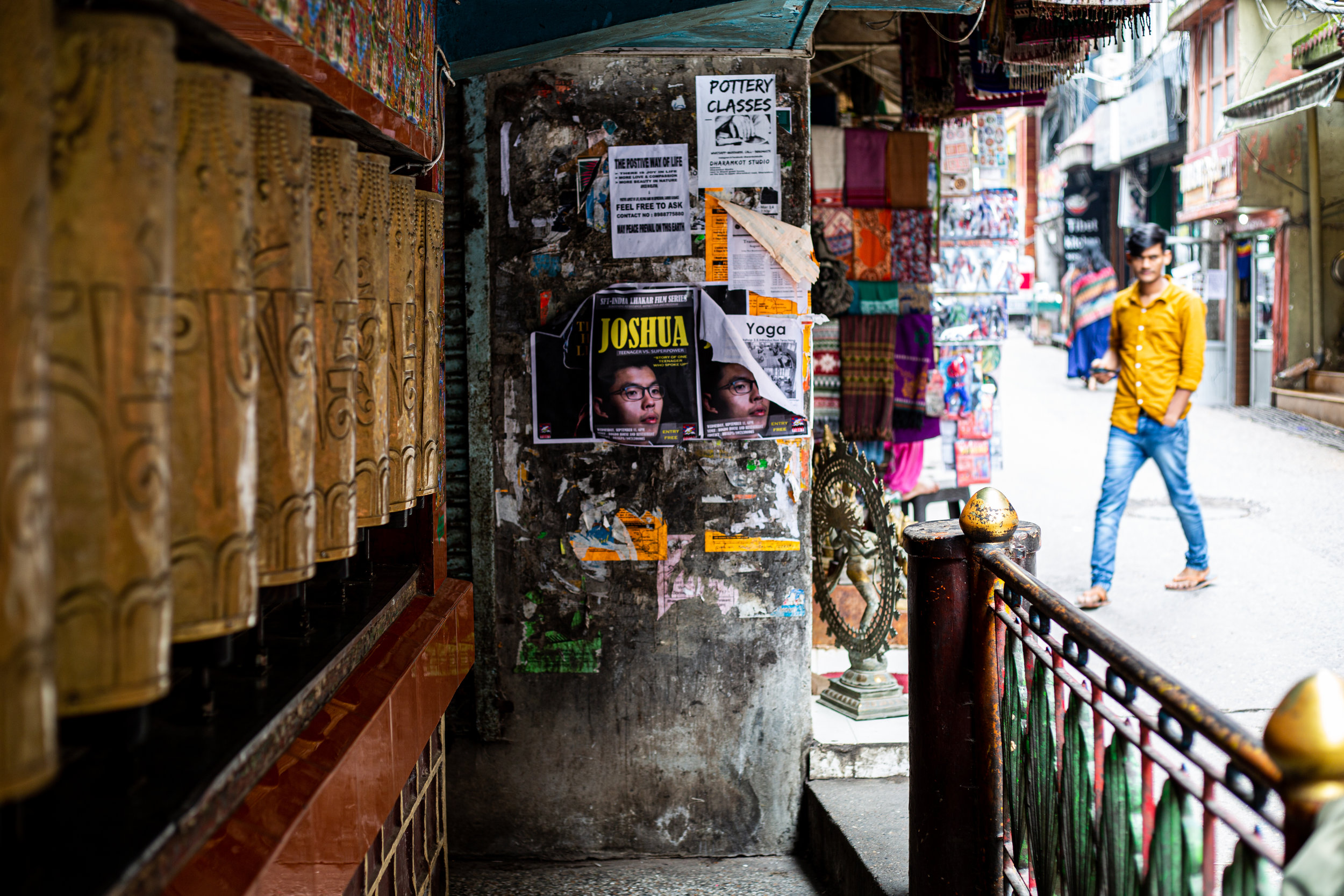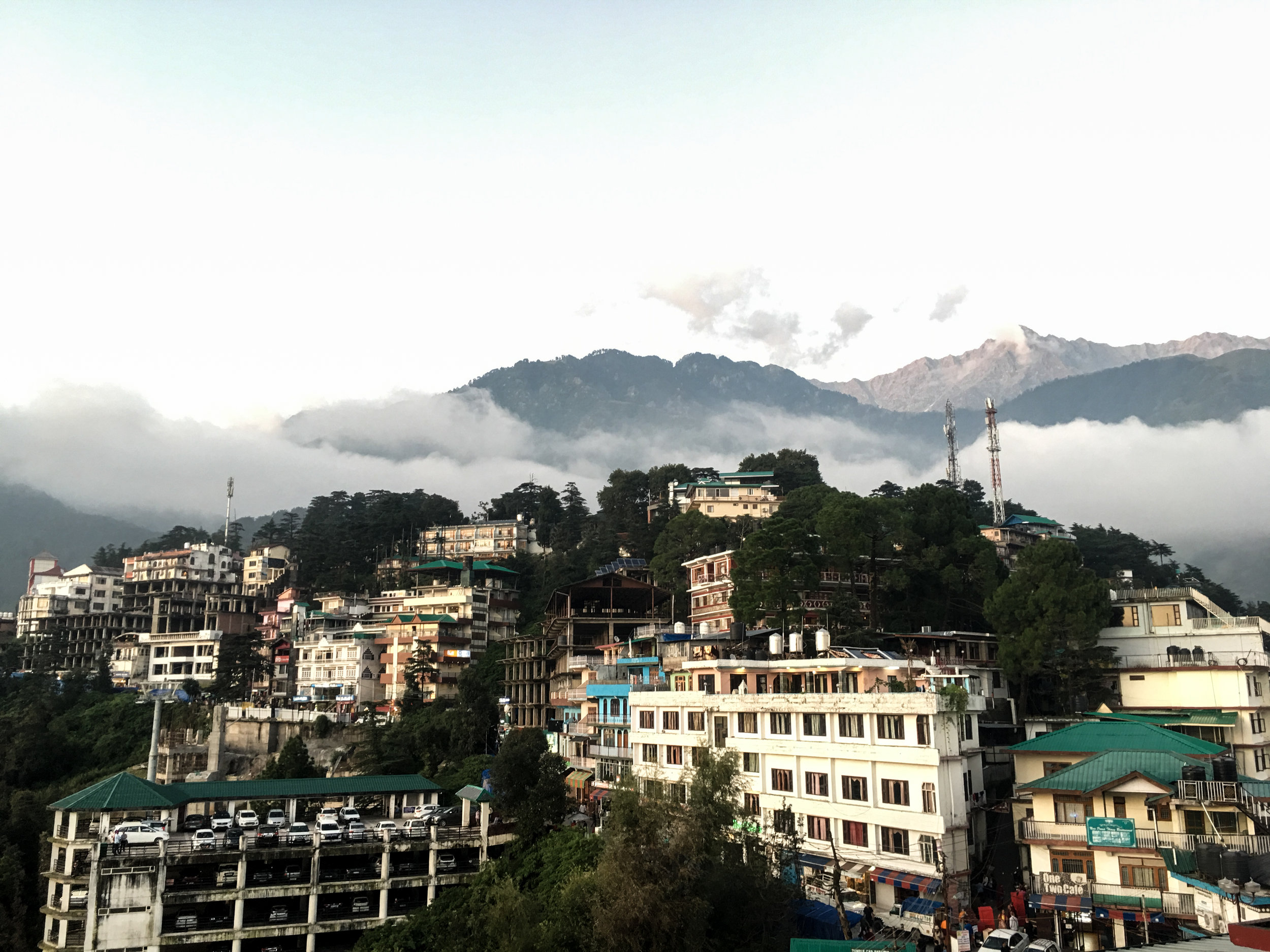The Hong Kong Protests Are Inspiring Tibetan Refugees in India
Lobsang Tsering, vice-president of the Tibetan Youth Congress, sitting in the organization's office. The portrait of the Tibetan spiritual leader, the Dalai Lama, hangs on the wall behind him. Photo by Avinash Giri.
DHARAMSHALA, India — Tashi Dhondup was a kid when he fled his homeland, Tibet. Travelling with a group of Buddhist monks escaping Chinese persecution, Dhondup eventually reached the Himalayan city of Dharamshala, India’s largest Tibetan refugee settlement.
A recent college graduate, Dhondup wants to serve the Tibetan government-in-exile based in Dharamshala, hoping that he and his people will return to a free Tibet someday.
Sitting in a small office of Students For a Free Tibet (SFT), a non-profit campaigning for Tibet’s independence from China, Dhondup expressed how inspiring the protests in Hong Kong have been for Tibetans fighting against China for over six decades. A poster of Joshua Wong, a well-known Christian pro-democracy activist in Hong Kong, was glued prominently to the wall behind him.
“The Hong Kong protests have given us a hope that we are not alone in this fight against Chinese oppression,” Dhondup said. “If we continue our decades-old struggle for our independence, we will succeed.”
Because of their common struggle against China, the Tibetan refugees are closely watching the battle unfolding in Hong Kong. Posters and flyers dot the walls and fences along the city’s winding streets, connecting the pro-democracy movement in Hong Kong to the 60-year non-violent Tibetan struggle for freedom. Tibetans have also organized solidarity protests for Hong Kong democracy in Delhi and Dharamshala.
“As a Tibetan, as a youth, as an activist, the protests in Hong Kong have re-energized our struggle,” said Tenzin Lobsang, development director of the Students For a Free Tibet. "We have been fighting for a long time, and over time, we started giving up, as the world community also doesn't pay attention to our struggle. The protests in Hong Kong have given us new hope that we should continue our resistance."
Posters of Joshua Wong, one of the leading pro-democracy leaders in Hong Kong, were pasted over many walls in the streets of Dharamshala, the largest Tibetan settlement in India. Photo by Avinash Giri.
Lobsang also expressed his admiration for Joshua Wong, who was a teenager when he rose to prominence for his role in the 2014 Hong Kong pro-democracy protests known as the Umbrella Movement.
“People like Joshua Wong have taught us how young people can lead millions of people in protests against one of the most powerful countries in the world,” Lobsang said.
Though Hong Kong’s protests this summer have remained leaderless, young Hong Kongers have used the encrypted messaging app Telegram to report updates on the protests and incidents of violence.
“We remain in awe with what the younger generation in Hong Kong is doing,” said Lhagyari Namgyal Dolkar, the youngest member of the Tibetan parliament-in-exile. “I’m stunned by how they have been so consistent in their struggle against authoritarian China.”
Dolkar, 32, said that usually the movements against China “spike up and die,” but the Hong Kongers are not ready to back down. “So far, the longest protests against China have been the 2008 protests in Tibet which continued for over five to six months. Now, the Hong Kong protests are the second-longest protest, and it’s a big deal.”
She said that one of the key features of the protest has been the coordinated efforts between the younger and older generations. “It has also touched me emotionally how the older generation came out in support of the younger ones after the police started using force against them. This is something that Tibet lacks. I’m jealous of them!”
Situated in the lap of mountains and surrounded by dense green forests, Dharamshala is usually lost in clouds. Photo by Avinash Giri.
A shared concern of Chinese overreach
The present string of protests in Hong Kong began in June to oppose an extradition bill which would have allowed mainland China to extradite accused criminals from Hong Kong. China’s Communist Party controls the country’s judiciary, but Hong Kong has an independent judiciary. The Hong Kong government withdrew the bill this month, but the protestors are still demanding many political reforms, including fair elections and police accountability. They want to protect their freedom of speech and right to protest, unique among Chinese cities and inherited through 150 years of colonization by the British. Hong Kong became part of China in 1997 under the “one country, two systems” policy that grants the city autonomy in most affairs. The 50-year agreement will end in 2047, causing some to fear a loss of their democratic rights.
Tibetan exiles believe the fate of Hong Kong could be the same as what Tibet has seen. “The people of Hong Kong have tasted democracy, and they know about the atrocities that China has been doing in Tibet,” said Youdon Aukatsang, a member of the Tibetan parliament-in-exile. “They know what their future could be after the 50-year period ends. The freedom, human rights, and democracy that Hong Kong enjoys are at stake.”
Tibetans, who largely follow the Dalai Lama’s Tibetan Buddhism, have maintained a non-violent freedom movement against China for the past 60 years, since the beginning of the Cold War era.
China claimed the region in the 1950’s, killing tens of thousands of people who resisted communist rule. The 14th Dalai Lama, Tibet’s spiritual leader who fled to India with hundreds of followers in 1959, has been the face of the Free Tibet movement. More than 130,000 Tibetans live under asylum in India today.
Beijing has always called Tibet an integral part of China and rejects the Dalai Lama and his followers as terrorists. Chinese authorities “severely” restrict religious freedom, speech, movement, and assembly in the region, and this year intensified surveillance of online and phone communications, according to Human Rights Watch. This year, new Chinese regulations in Tibet also restrict local traditions like community mediation by monks.
Although the struggle for a free Tibet has been non-violent, so far around 152 Tibetans have self-immolated themselves protesting against the alleged ongoing brutal repression by Chinese authorities. The latest self-immolation was a 14-year-old boy in Tibet.
“Tibetans are self-immolating themselves out of helplessness as nobody is listening to our demands,” Lobsang Tsering, vice president of the Tibetan Youth Congress, said. “We are non-violent people. We can't wear a suicide vest and kill others. But the fire is burning in our hearts, which results in some of us committing such acts."
According to some media reports, the Chinese government has warned those in Tibet not to share content related to Hong Kong on social media, or else face eight years imprisonment.
The streets of McLeodganj in Dharamshala are famous for Tibetan Buddhist monks clad in their crimson robes. The place is also called "mini Lhasa" after the Tibetan capital and is the home of the exiled Dalai Lama. Photo by Avinash Giri.
Protesting China, in India, is tricky
The Tibetan Youth Congress, one of the oldest organizations fighting for an independent Tibet, has organized several protests in Dharamshala and other parts of India, but protesters have to be careful.
"India has been very generous in granting asylum to us,” Tsering said. “We are not allowed to organize large-scale protests like Hong Kong.”
Giving Tibetan refugees a home has put India in rough diplomatic relations with neighboring China. The countries fought a war in 1962 over territorial disputes, and have still not agreed on some parts of the border. While the Indian authorities have been trying to build a warm relationship with Beijing, the Tibet issue has become more complicated. Although India has hosted the Dalai Lama and thousands of his Tibetan followers, it has set a condition that they don't protest against the Chinese government in India. Many, including the Dalai Lama, has called the attitude of Indian authorities "overcautious.”
The Tibetan freedom struggle was historically for independence from China, but in 2008, the Tibetan government-in-exile under the Dalai Lama’s leadership officially adopted the Middle Way Approach, seeking more political autonomy and religious freedom within China, and not complete independence.
While the Dalai Lama is the most significant unifying figure of the Tibetan struggle, this decision upset many Tibetans – organizations like Tibetan Youth Congress and Students For a Free Tibet still openly demand independence from China, and continue to stage protests in India and elsewhere. On Sept. 29, members of the Students For a Free Tibet marked the fifth anniversary of the Umbrella Movement in Delhi and Dharamshala.
Young Tibetans search for their own Joshua Wong
Many young Tibetans feel that the Tibetan exile government needs to change its position from the Middle Way to complete independence from China. Talking about the shortcomings in the Tibetan struggle, Lobsang said that unlike Hong Kong where young guys, including teenagers, have led the protests, the trust in the younger generation lacks in Tibet. "We, as a youth, don't enjoy the confidence of the older people, who are leading the struggle currently. They think we can't do it well. It's something that they should learn from Hong Kong and change."
Lobsang also said that Tibet's profound devotion towards Buddhism and its activism against China are at conflict.
"The Buddhist teachings of the Middle Way Approach are also causing damage to our struggle,” Lobsang said. “Our government has already left the claim of independence following the Buddhist path. This is exactly what China wanted. Following the kind teachings of Buddha, we may end up giving everything to China one day."
Many Tibetans don’t believe in the communist regime of China, and they fear that even if they get the autonomy they are demanding under the leadership of the Dalai Lama, it won't change anything.
"The case of Hong Kong is a clear lesson that autonomy in Chinese rule won't work, no matter what the degree is,” Dhondup said. “The oppressive Chinese regime will always try to undermine it.”
“If we want to make a difference, we will have to go back to Tibet and fight from inside,” Dhondup added. “No matter how brutal Chinese suppression would be if all of us go back and resist, we can win.”
Tenzin Dalha, a young researcher at the Tibetan Policy institute, said that Tibetans need their own Joshua Wong figure to build broader resistance against China.
Hong Kong has prepared the ground for a broader struggle in which all the communities “suffering from Chinese oppression, like Tibetans, Uighurs and others” should participate, he said. “This is the best time to rise against the Chinese occupation.”




